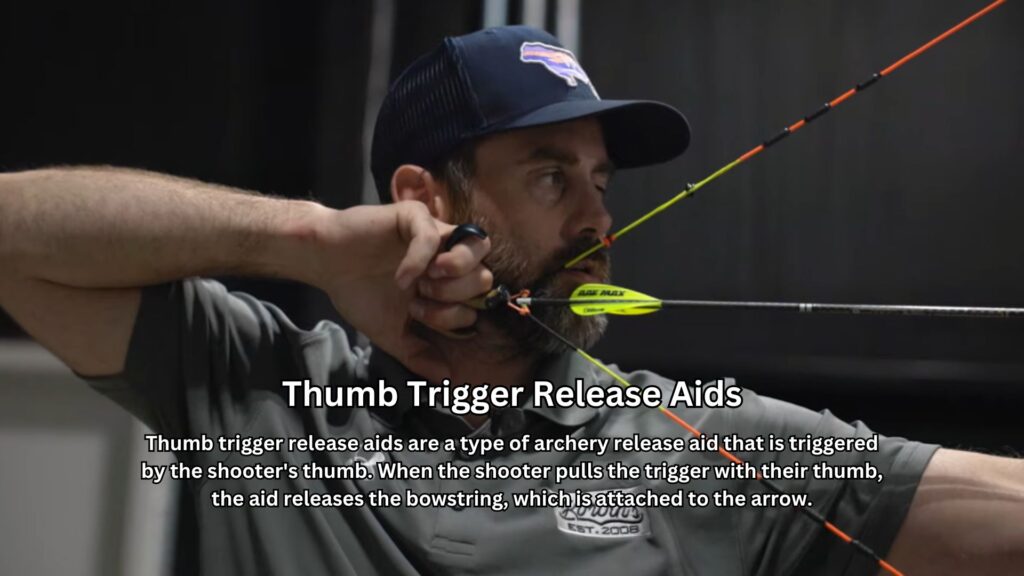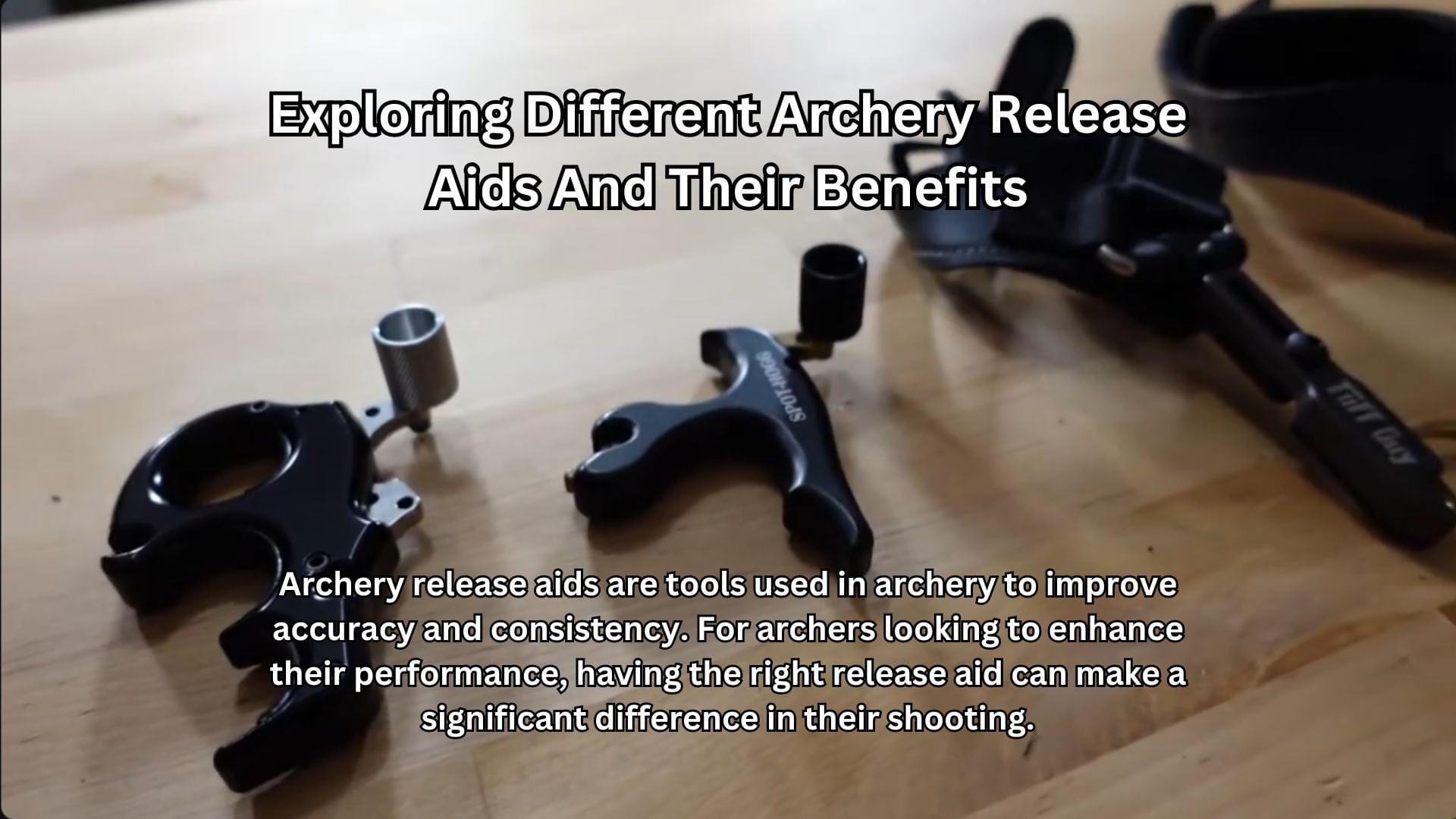Archery release aids are tools used in archery to improve accuracy and consistency. For archers looking to enhance their performance, having the right release aid can make a significant difference in their shooting.
There are different types of release aids available, and each comes with its benefits. Some are designed to provide a cleaner release, while others reduce the amount of trigger travel. Additionally, some are adjustable, offering greater customization to suit individual preferences.
Finding the right release aid can help archers achieve greater accuracy and precision in their shooting. In this article, we’ll explore different types of release aids and their advantages to help you make an informed decision.
Thumb Trigger Release Aids
Explanation Of Thumb Trigger Release Aids
Thumb trigger release aids are a type of archery release aid that is triggered by the shooter’s thumb. When the shooter pulls the trigger with their thumb, the aid releases the bowstring, which is attached to the arrow. This type of release aid is commonly used in compound archery, offering a quick and easy way to aim and shoot at the target with a clean release.

Comparison With Other Types Of Release Aids
Thumb trigger release aids are one of the most popular types of release aids used in archery. Compared to other types of release aids, such as back tension release aids, thumb trigger release aids are easier to handle and use.
They also provide a consistent release, which is especially important when shooting for accuracy and precision.
Advantages And Disadvantages Of Using Thumb Trigger Release Aids
Advantages:
- Easy to use, making it ideal for beginners
- Provides a consistent release, which is essential for accuracy and precision in archery
- Quick and efficient, helping to improve the speed of shooting
- Reduces the risk of jerking or flinching, which can cause the arrow to go off-target
- Reduces the strain on the shooter’s fingers and hand, making it more comfortable to use
Disadvantages:
- Can be less accurate at longer ranges, due to the sensitivity of the trigger
- Requires consistent trigger finger placement to be effective
- Can be affected by the shooter’s grip on the bow handle
- Not suitable for all types of archery, such as traditional archery
Situations In Which Thumb Trigger Release Aids Are Most Effective
Thumb trigger release aids are particularly effective in situations where accuracy and speed are important. They are ideal for hunting and target shooting, as well as 3d archery. They are also a great choice for beginners who are just starting to learn how to shoot a bow and arrow, as they are easy to use and provide consistent results.
The Impact Of Thumb Trigger Release Aids On Accuracy And Consistency
Using a thumb trigger release aid can have a significant impact on accuracy and consistency in archery. By eliminating the need to pull the bowstring manually, it provides a consistent release that is essential for accuracy and precision. This can be an especially important factor in target shooting, where even small deviations from the target can have a significant impact on the result.
Techniques For Using Thumb Trigger Release Aids To Achieve Optimal Results
To achieve optimal results with a thumb trigger release aid, it is important to practice and perfect your technique. Some tips for using a thumb trigger release aid include:
- Maintaining consistent trigger finger placement
- Relaxing your grip on the bow handle
- Pulling the trigger with a smooth and steady motion
- Maintaining good posture and form throughout the shot
- Practicing regularly to improve your aim and consistency
By following these techniques, you can make the most of your thumb trigger release aid and achieve optimal results in your archery practice.
Back Tension Release Aids
Exploring Different Archery Release Aids And Their Benefits
Archery is a sport that requires a lot of focus, patience, and precision. One critical aspect of archery is choosing the right release aid, which is instrumental in achieving accuracy and consistency in every shot. This blog post will delve into different types of archery release aids, specifically focusing on back tension release aids.
Explanation Of Back Tension Release Aids
Back tension release aids are designed to minimize hand and finger movement during the release process, primarily relying on the back and shoulder muscles to release the arrow. As the archer draws the bowstring back, the release aid’s sear engagement triggers a rotation that increases tension on the bowstring.
The increase in tension causes the bowstring to release, discharging the arrow towards the target.
Comparison With Other Types Of Release Aids
Unlike other types of release aids that require the archer to actively engage their index finger or thumb to release the arrow, back tension release aids rely solely on the archer’s back tension. This makes it different from wrist strap and thumb release aids, as it requires a lot more technique and strength.
Advantages And Disadvantages Of Using Back Tension Release Aids
Like any other piece of archery equipment, back tension release aids have their advantages and disadvantages. Here are some of them:
Advantages:
- Use of larger muscle groups leads to better consistency and accuracy in each shot.
- Trains the archer to develop a consistent and fluid release motion.
- Minimizes the risk of target panic.
- Helps calm the mind and keep a stable anchor point.
Disadvantages:
- Requires a higher level of skill to master.
- Not suitable for archers with poor back muscle strength.
- May not be ideal for archers who need to make quick shots.
Situations In Which Back Tension Release Aids Are Most Effective
Back tension release aids are effective in several situations, including:
- When archers are looking to improve their accuracy and consistency in each shot.
- When archers want to train themselves to have a more fluid release motion.
- When archers are battling with target panic and need a release aid that steadies their release motion.
- When archers are looking for a quiet release aid that does not make a sound like wrist strap equivalents.
The Impact Of Back Tension Release Aids On Accuracy And Consistency
Back tension release aids have a significant impact on accuracy and consistency in each shot. The aid improves accuracy by promoting a fluid and consistent motion during the release process. It also eliminates errors caused by jerky motions by relying on larger muscle groups.
Additionally, back tension release aids promote consistency by minimizing any form of muscle tension during the release.
Techniques For Using Back Tension Release Aids To Achieve Optimal Results
Here are some of the techniques that archers can use to achieve optimal results when using back tension release aids:
- Archers should train themselves to have a consistent anchor point.
- Archers should ensure that they have a relaxed grip on the bow handle to avoid any unnecessary movement.
- Archers should also keep their shoulders in-line to promote a straight pull during the release process.
- Archers can practice by using a back tension release aid with a clicker attachment. The attachment provides feedback on the point at which the archer reaches the optimal tension level, and the arrow should be released.
Resistance Activated Release Aids
Exploration Of Resistance Activated Release Aids
When it comes to archery release aids, resistance activated release aids are gaining popularity amongst archers. Contrary to other types of release aids, resistance activated release aids have specific features that provide unique benefits for archers. In this blog post, we will explore different archery release aids, with emphasis on resistance activated release aids with respect to the following subheadings:
Explanation Of Resistance Activated Release Aids
Resistance activated release aids are designed to respond to the pressure that an archer applies to their bowstring. This design produces a triggering effect once the preset pressure is reached. The release aid’s firing mechanism is initiated, resulting in the release of the bowstring.
Comparison With Other Types Of Release Aids
Unlike other types of release aids, a resistance activated release aid operates on a “hair-trigger” design, which decreases the time required for firing due to the sudden application of power to the release. These types of release aids can either have a flexible or rigid trigger, which are preferred in situations where fast, reactive shots are essential.
Advantages And Disadvantages Of Using Resistance Activated Release Aids
Advantages:
- The “hair-trigger” design provides fast, reactive shots, which is why it is preferred among hunters and 3d shooters.
- Resistance activated release aids provide consistent release pressure, thereby reducing torque on the bowstring, hence increasing accuracy in shots.
Disadvantages:
- Resistance activated release aids can be sensitive to the slightest pressure, resulting in inadvertent triggering of the firing mechanism, commonly referred to as a “punch.” Higher levels of skill and training are required before attempting to use them in live hunting situations.
- The pressure required for firing the release aid is pre-set and cannot be easily adjusted, which can be problematic for archers requiring different poundage levels of bow draw.
Situations In Which Resistance Activated Release Aids Are Most Effective
Resistance activated release aids are most effective when the following requirements are needed:
- Fast, reactive, and consistent shots with minimal torque on the bowstring.
- Hunters and 3d shooters.
- High levels of skill in using the release aid.
The Impact Of Resistance Activated Release Aids On Accuracy And Consistency
The hair-trigger design, combined with a consistent release pressure on the bowstring, reduces torque on the bowstring, thereby increasing accuracy in shots. This release aid enhances consistent and accurate shots, providing the archer with confidence in their shooting prowess.
Techniques For Using Resistance Activated Release Aids To Achieve Optimal Results
To achieve the best results from a resistance activated release aid, archers need to master the following techniques:
- Achieve the correct angle on the release aid.
- Use the index finger to anchor the release aid onto the bowstring.
- Apply steady pressure with your thumb until the trigger is engaged for the arrow to be released.
Overall, resistance activated release aids provide specific benefits for archers seeking consistent and accurate shots. However, higher skill levels are required to use these types of release aids effectively.
Punch Trigger Release Aids
Explanation Of Punch Trigger Release Aids
If you’re looking for a release aid that focuses on clean and precise release of the bowstring, then punch trigger release aids might be the right choice for you. This type of release aid adopts a different mechanism from other conventional release aids.
Instead of using a hinge or a thumb/button trigger to initiate a release, punch trigger release aids operate by punching the release trigger with your index finger to release the bowstring. There are a few advantages to this approach, which we’ll discuss below.
Comparison With Other Types Of Release Aids
Punch trigger release aids are quite different from other types of archery releases such as thumb, index finger, and hinge releases. Thumb releases use the shooter’s thumb to activate the trigger, while index finger releases require the shooter’s index finger to activate the trigger.
Hinge releases need the shooter to balance the release aid on a pivot point, with it releasing automatically when pressure is applied on the bowstring. Compared to these types of releases, punch trigger release aids require the shooter to use a hard punch, which isn’t always the best choice in all circumstances.
Advantages And Disadvantages Of Using Punch Trigger Release Aids
Advantages:
- Punch trigger release aids are precise and consistent.
- They have minimal creep, which means the trigger cannot be gradually pulled back.
- Punch trigger release aids are adjustable and can be customized for tension, travel, and poundage settings.
- They provide a quick and clean release, which improves accuracy and stability.
Disadvantages:
- Punch trigger release aids can be uncomfortable for some shooters.
- They require a bit of training and practice to get accustomed to them.
- They are not as versatile as index finger or thumb releases.
- They can’t be used with a string loop.
Situations In Which Punch Trigger Release Aids Are Most Effective
Generally, punch trigger release aids are suitable for archers who want a clean and precise release. However, they are not ideal for all situations. For instance, they work best in target archery, where a single-point release can help to maintain consistency and accuracy.
They can also be used in bowhunting, but only in situations where a quick and accurate release is essential.
The Impact Of Punch Trigger Release Aids On Accuracy And Consistency
When used correctly, punch trigger release aids have a positive impact on accuracy and consistency. As they use a single-point release, it becomes effortless to execute accurate shots repeatedly. Additionally, punch trigger release aids have minimal trigger travel, making it possible to have consistent shots in quick succession.
Techniques For Using Punch Trigger Release Aids To Achieve Optimal Results
To achieve optimal results using punch trigger release aids, a shooter needs to employ the following techniques:
- Ensure that the release aid is adjusted correctly to fit your hand size and bow poundage.
- Practice regularly to get accustomed to the technique required for execution.
- Use a relaxed grip and focus on punching the trigger with your index finger.
- Employ a controlled follow-through to avoid torque on the bowstring upon release.
Punch trigger release aids are highly effective in situations where a clean and precise release is required. However, they might not be the best option for everyone and should only be used by someone who has experience with them. Employing the correct techniques is crucial, so ensure that you practice regularly to get the most out of this type of release aid.
Frequently Asked Questions On Exploring Different Archery Release Aids And Their Benefits
How Do Release Aids Work In Archery?
Release aids enable the archer to pull the bowstring using a trigger release or back tension release. These aids help improve accuracy and consistency by providing a smooth release and reducing string torque.
What Are The Benefits Of Using A Thumb Release?
Thumb releases offer a relaxed and natural grip while providing consistent draw length, anchor point, and release. They are ideal for hunters and target archers who want to enhance their accuracy and consistency.
What Is A Back Tension Release, And How Does It Work?
A back tension release is a type of release aid used in archery that relies on muscle tension to release the string instead of a trigger. This encourages proper form, helps remove target panic, and minimizes accuracy-robbing torques.
How Do Hinge Releases Differ From Other Release Aids?
Hinge releases, also known as back tension releases, are designed to release the bowstring once the bow reaches full draw from an open sear. They’re often preferred by experienced archers who prioritize shot process over speed and precision, as they can promote focus and provide consistent release.
Can Release Aids Improve My Archery Performance?
Yes, release aids can help improve your archery performance by providing a consistent, smooth, and accurate release, thereby reducing torque, increasing accuracy and consistency, and enhancing overall precision. They can also help reduce wound rates by facilitating cleaner kills.
Conclusion
After exploring the different archery release aids and their benefits, it’s clear that the type of release aid chosen can have a significant impact on accuracy, consistency and overall performance. Whether it’s a wrist strap, thumb release or back tension release, each has its unique advantages.
It’s important to find a release aid that feels comfortable and easy to use, as this can boost confidence while shooting. Understanding the different types of release aids and their features can help in making an informed decision when selecting a release aid.
Ultimately, practice and training are essential for perfecting the shot, no matter what release aid is chosen. By using the right release aid for individual shooting styles and preferences, archers can optimize their performance and enjoy the sport to the fullest.

